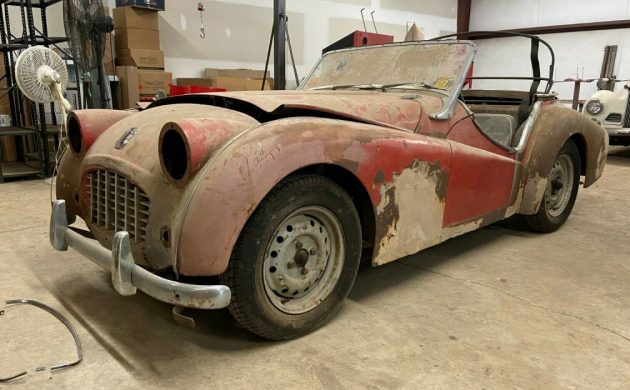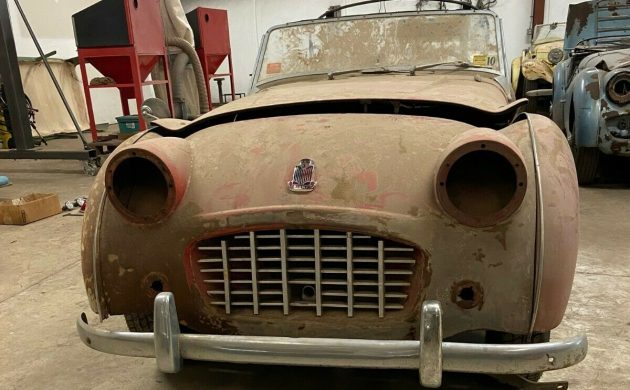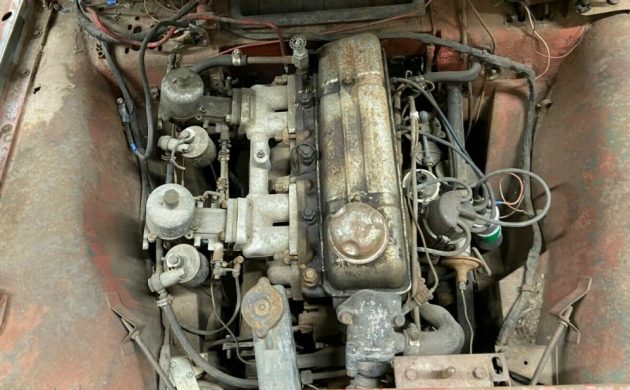Upon review of this 1957 Triumph TR3, one might be inclined to assume that some previous owner had cornered the Bondo market somewhere in the past and really went to town. Many of the TR3s that are featured here are in a similar deleterious condition so this example isn’t too much of a surprise. But as is always the case, sometimes there is more to a car than the listing details – perhaps that’s the case here. This TR3 is located in Brunswick, Georgia and is available, here on eBay for a BIN price of $5,000.
This TR3 has what the seller refers to as a “small-mouth grille” or what is referred to in traditional circles as a “pre-facelift” (’55-’57) version. Over 13K of such rolled off of the Coventry, England assembly line with most finding their way to the U.S. This example has been parked for 30 years or so and it would appear that a former owner lost interest in a redo so here she sits. The seller adds, “Almost all of the pieces that have been removed from the car are in the spare parts. There are also some NOS parts included…” And while that’s good to know there are two things that will need attention, one is existing rust, a regular resident of most TR3s, and the other is the Bondo – it’s gotta’ go. “Very restorable” or not, the result will be dismal unless all of that mud is dug out and then followed up with proper repairs.
I found the seller’s statement, “The previous owner said the engine is original to the car, and I believe him since the VIN and engine number are very close” to be a bit odd. Close only counts in horseshoes and hand grenades, so I would think the VIN and engine number would need to match, not just be very close. Anyone who can provide more insight into this matter as it relates to Triumphs is welcome to chime in. Regardless, it’s a safe bet that the 95 or 100 HP (depends on the cylinder head employed), 2.0 liter, in-line four-cylinder engine hasn’t turned a lick in many moons. If nothing else, the motor looks complete and it should be connected to a four-speed manual transmission.
The interior isn’t exactly gutted but it is grimy. The seats are rough and the dash is even worse though all of the gauges are still on the job; some switchgear, however, could be missing. The transmission cover has been removed for one reason or another and the floors, despite the detritus, look sound. The entirety is going to need a complete makeover but it is, at least, a compact environment.
My assumption is that the seller acquired this TR3 with restoration plans, and then thought the better of it. There is a nice collection of parts included and they are displayed in an orderly fashion as opposed to being tossed into numerous, unmarked plastic bins, usually the case with such projects. Regardless, the next owner will have their work cut out for them in attempting to bring this Triumph back to life, wouldn’t you agree?







TR vins and engine never matched, as engines were also made for other cars and companies. So I’d tend to agree with the seller on this.
OK, good to know!
JO
Must be a high performance tractor engine. Note the dual exhaust.
This should be a TR2 with the small grill. TR3’s had the wide grill.
No, TR2 went out of production in ’55 and the trim tag on this example proclaims it as a TR3.
JO
Very obviously a TR3 in original design form. This grill unique to the first TR3 model, later TR3s were the wide mouth. TR2 had a grill set back in the opening, just in front of the radiator.
TR2s had the recessed “egg crate” grill. The TR3 moved it forward.
The door handles went to the outside, and the grill was widened on the TR3A. The older TR3 models had a small grille.
Unless the block has a .50 bullet hole in it, or other serious damage, the cylinders/wet sleeves can be replaced with new sleeves and 87mm pistons. Not hard to get the parts. You can even order the required new floor pans from E Bay, Amazon, Moss Motors or The Roadster Factory.
The Chassis and rust or damage to it is the key question on these. Most of the body panels bolt on and off. But that frame is critical.
The parts are out there. Last year I ordered a complete TR3 Cam and Competition Valve Train from “Isky” for my rebuild.
The “Small Mouth” TRs have a certain attraction to some folks and collectors. Same as the hard to find TR3Bs.
The “dual exhaust” has to be a joke. Maybe somebody hung an extra exhaust pipe they had in the garage for laughs.
DonP,
Yes the chassis main side rails DO rust out at the bottom because they are square tube in design, with open rear ends. This allows water to accumulate inside the tubes, and the low points of the chassis do rust out, but they are very repairable. Any TR2 thru 6 that has sat outside long term in a climate where it rains a lot, will likely have rusty chassis side rails at the bottoms, just forward of the rear axle.
My shop repaired many of these frames, but to do it right the body should come off. These cars are so simple to work on, & it’s really easy to pull the body off the chassis.
I think this vehicle is beyond repair.
Nothing is beyond repair if you have time and/or money. Tackled a few like this one over the years. In my case, most were done with lots of time due to the limited money supply. Still fun. Used up a lot of sheet metal on this one.
I disagree, I ran a restoration shop that repaired and restored hundreds of these cars, many of them far worse than this car. The TR3 thru TR3B cars are basically a pre-WW2 designed vehicle made into the 1960s, and are about as simple as one can find, plus EVERY part needed is available. I would compare them to the Ford model A in complexity and parts availability.
The most complicated part of these cars is the optional Laycock-de Normanville overdrive, and those are available on an exchange basis from numerous rebuilders, ready to install. They are a great car for beginner restorers. I’ve often joked that the TR3 was a “Fast tractor” because of it’s simplicity!
As far as the dual exhaust tips, I’ve seen TR2 to 4 cars with tube headers that use a larger single pipe along the gearbox, then become dual exhausts in the rear section.
Take it all apart & blast the whole mess with dry-ice.